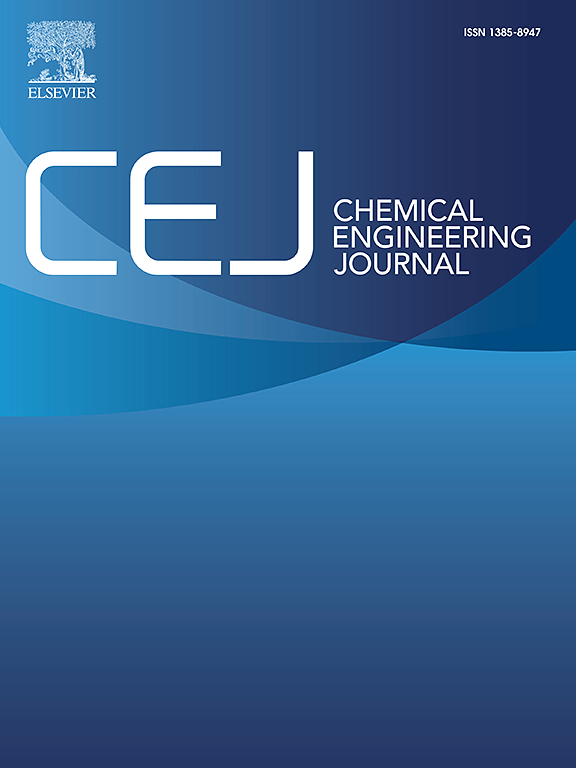废锂离子电池高温冲击超快气固合成Li4SiO4吸附剂
IF 13.3
1区 工程技术
Q1 ENGINEERING, CHEMICAL
引用次数: 0
摘要
从废旧锂离子电池(lib)中收集功能材料提供了一个机会,可以提高通过回收获得的产品的经济价值,同时减少与电池废物管理相关的环境足迹。本研究报告了一种创新的高温冲击(HTS)驱动气固(G-S)合成策略,利用废LiCoO2 (LCO)粉末中的锂(Li)高效制备Li4SiO4吸附剂。在大约1000 °C的初始HTS步骤诱导LCO基体中的Li2O快速原位汽化,随后与SiO2粉末反应,形成前体材料,同时将LCO残留物还原为金属钴(纯度>;96 %)。在1200 °C下,经过20 s的瞬态热锂化处理,成功合成了Li4SiO4吸附剂。通过先进的表征和理论计算,阐明了高温高温诱导Li挥发和G-S合成机理。所得的Li4SiO4吸附剂表现出良好的CO2吸附性能,在15 vol%的CO2气氛下,经过20个连续的吸附-解吸循环后,其吸附量稳定在0.193 g/g。本研究介绍了一种新的短过程、高效、可持续的废lib升级回收策略,并为快速合成功能材料提供了新的途径。本文章由计算机程序翻译,如有差异,请以英文原文为准。

Ultrafast gas–solid synthesis of Li4SiO4 sorbent from spent lithium-ion batteries via high-temperature shock
Harvesting functional materials from spent lithium-ion batteries (LIBs) presents an opportunity to enhance the economic value of products derived via recycling while mitigating the environmental footprint associated with battery waste management. This study reports an innovative high-temperature shock (HTS)-driven gas–solid (G–S) synthesis strategy that leverages the lithium (Li) from waste LiCoO2 (LCO) powder to efficiently prepare Li4SiO4 sorbent. An initial HTS step at approximately 1000 °C induces rapid, in situ vaporization of Li2O from the LCO matrix, which subsequently reacts with SiO2 powder, forming a precursor material while simultaneously reducing the LCO residue to metallic cobalt (purity >96 %). The Li4SiO4 sorbent was successfully synthesized following a transient thermal lithiation treatment at 1200 °C for 20 s. The HTS-induced Li volatilization and G–S synthesis mechanisms were elucidated via advanced characterization and theoretical calculations. The resultant Li4SiO4 sorbent demonstrated commendable CO2 adsorption performance, maintaining a stable adsorption capacity of 0.193 g/g after undergoing 20 consecutive adsorption–desorption cycles under a 15 vol% CO2 atmosphere. This study introduces a novel short-process, highly efficient, and sustainable strategy for the upcycling of spent LIBs and illuminates new pathways for the rapid synthesis of functional materials.
求助全文
通过发布文献求助,成功后即可免费获取论文全文。
去求助
来源期刊

Chemical Engineering Journal
工程技术-工程:化工
CiteScore
21.70
自引率
9.30%
发文量
6781
审稿时长
2.4 months
期刊介绍:
The Chemical Engineering Journal is an international research journal that invites contributions of original and novel fundamental research. It aims to provide an international platform for presenting original fundamental research, interpretative reviews, and discussions on new developments in chemical engineering. The journal welcomes papers that describe novel theory and its practical application, as well as those that demonstrate the transfer of techniques from other disciplines. It also welcomes reports on carefully conducted experimental work that is soundly interpreted. The main focus of the journal is on original and rigorous research results that have broad significance. The Catalysis section within the Chemical Engineering Journal focuses specifically on Experimental and Theoretical studies in the fields of heterogeneous catalysis, molecular catalysis, and biocatalysis. These studies have industrial impact on various sectors such as chemicals, energy, materials, foods, healthcare, and environmental protection.
 求助内容:
求助内容: 应助结果提醒方式:
应助结果提醒方式:


